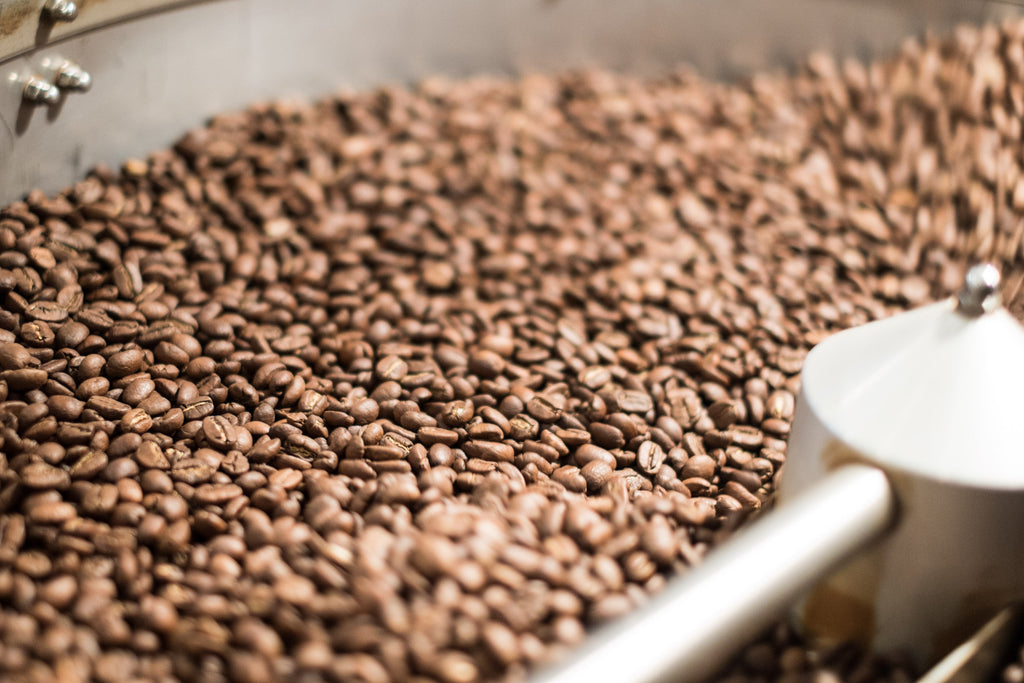Coffee roasting: A short excursion into production

The perfect cup of coffee is a complex process that begins on the coffee farm and ends with the barista. In between, many steps are necessary to produce an excellent product. We'd like to explain one of them, roasting, in this article.
Drum roasting
We roast our coffee in a 15 kg handmade drum roaster from Greece. The constant movement of the beans in the drum influences the convective and conductive heat transfer. The roaster itself is powered by liquid gas, and a flame directly beneath the drum provides the heat. In addition to the temperature, the airflow and drum speed can be adjusted to suit the roasting profile and the roasting phase. Unlike fast industrial roasting processes with very high temperatures, the beans are given more time to develop in the drum.

Roasting machine from Coffeetool from Greece
Fresh, high-quality green coffee
The basic product, the raw or green coffee, is packaged in 60-70 kg grain-per-pack jute sacks, with specialty products also vacuum-packed in 15 kg boxes. This product is stored at a temperature as stable as possible at around 18°C and low humidity. While green coffee is not perishable, it should be roasted within a year to develop its full flavor potential. How wonderful that coffee is harvested somewhere around the globe at any time of year.

Raw or green coffee
Roasting in three phases
Once the first batches are prepared and the roaster is nice and hot (at least 185°C), production can begin. Filling the drum with green coffee initially causes a sharp drop in temperature in the roaster. About 1.5 minutes after filling, the so-called "turning point" is reached, and the temperature begins to rise again.

Bean temperature and rate of rise (RoR)
This first phase is called the drying phase, during which the green coffee loses a particularly large amount of moisture and the chemical-physical processes begin. The dry distillation of organic compounds begins at around 100°C, and the first color changes are noticeable. Depending on the roasting profile, this takes up about one-third of the total roasting time.

Coffee during the dry phase
Maillard reaction
This is followed by the yellow, or Maillard, phase, from a bean temperature of around 150 degrees Celsius to the first crack at around 200 degrees Celsius. During this phase, the color of the beans begins to change from yellow to light brown. Amino acids and various sugars are converted into new compounds by the heat. The sugar increasingly caramelizes, and the beans continue to lose mass as water and volatile components evaporate. This also changes the density of the beans, which become increasingly porous and burst open.

Coffee during the yellow or Maillard phase
Where the magic happens
At around 200 degrees Celsius, the first crack begins, which is noticeable by a quiet crackling sound. As the beans burst, a particularly large amount of moisture escapes, simultaneously beginning the so-called development phase. This delicate phase is crucial for the coffee's flavor. The roastmaster determines the development time and thus the optimal balance between sweetness, acidity, and roasted aroma. The interplay between development time and bean temperature is particularly crucial for the flavor.

Coffee during the development phase after the first crack
Depending on the roasting profile, the development time can be expressed as a percentage of the total roasting time. Each roaster follows their own philosophy. In any case, the final bean temperature should not exceed 225°C before the beans crack for the second time (second crack). If this point is approached, burnt bitterness overpowers all the coffee's natural flavor components.

Coffee beans in the cooling tray after roasting
Once the development phase is complete, the beans are removed from the drum and collected in a cooling tray to cool quickly. The roaster blows cold air onto the hot beans from below to complete the roasting process as quickly as possible. At the end, the beans have lost around 15% of their weight, are almost twice as large as they were before roasting, and have absorbed a significant amount of CO2. This escapes primarily in the first 2-3 weeks after roasting. Only then does the coffee unfold its full flavor potential and is not overpowered by excessive roasted aromas.


Leave a comment